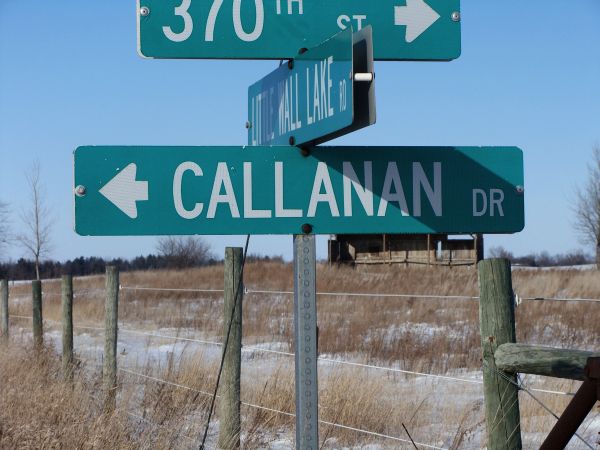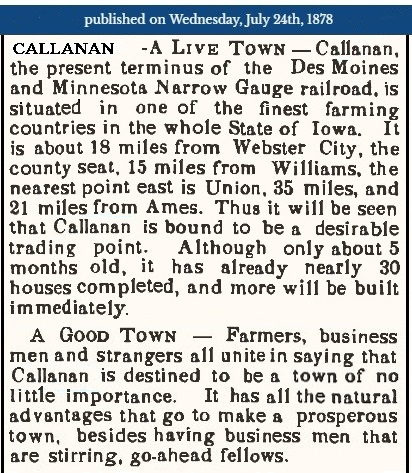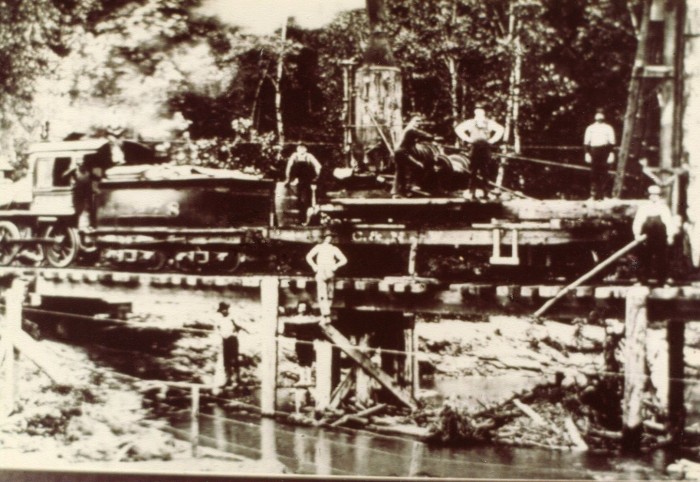|
Callanan, one of several nearby Early Settlements before Jewell Junction existed |
|
Callanan was the first platted town in the eastern portion of Iowa's Hamilton County. This settlement was established just before any railroads came to the area, and did not at first have a formal name. This settlement soon grew enough to extend north across the Ellsworth township into Lyon township. When
the Des Moines and Minneapolis Railroad finally came north from
Des Moines to Ames in the 1870s, the people which settled here wished to
be included on this new transportation roadway. It was determinded
that if the people in four townships in Hamilton County taxed themselves
5%, they might successfully use the money to invite the railroad company
to build north to this area. Although this settlement did not
yet have a name or title, they had discovered that a Mr. Callanan was the
primary investor of the railroad. This discovery convinced
them to adopt "Callanan" to be their community's name, so that the railroad
would be enticed to come there. The newer portion of the settlement,
located in Lyon Township, became known as "North Callanan."
|
 Typical of many road signs in Hamilton County, this sign on Highway 69 doesn't really indicate the way to Hamilton County's early settlement called Callanan. But it does indicate the Callanan really existed, and is noted as important in the history of Hamilton County. This sign is located about three miles south of Jewell on Highway 69, and the arrow points west. For the sign to really point towards the actual former town of Callanan, this sign would need to be relocated two miles north and two miles east. At that point, about one mile south of Ellsworth, the sign would actually point towards the spot where Callanan once was. Besides seeing Cairo Lake and Goose Lake, the towns known as Lakin's Grove, Ellsworth, Jewell Junction, Callanan and North Callanan can be seen on the following 1858 map which has been updated to also show the towns of today.
The Des Moines and Minneapolis Railroad had worked to finish the construction of the narrow gauge railway north of Ames and through Gilbert Station, Story City, and Randall. And because 5% of the income of the settlers in this area would be awarded to the railroad, the rail company decided to follow the restriction being set for receiving the money (construct the railroad within a mile of the corner of these four townships in southeast Hamilton County). The railroad needed to turn a bit East and cross the Skunk River to accomplish that. The track needed to go down hill, cross the Skunk River, and go up the hill into "town". This
settlement was actually platted. (View the map at the bottom of this
page.) The part lying in Ellsworth Township was platted in 1878.
The Lyon Township addition known as "North Callanan" was laid out in January,
1879. The town started with a great flourish and stores were doing
a good business and a newspaper was being printed. The settlement
grew and prospered until about 1880. Callanan became the "town" that
was known as the northern terminus of the narrow gauge line up north from
Ames and Des Moines.
|
|
in the Webster City Hamilton Freeman:
"Callanan, the new station on the D. M. & M. R. R., at the Four Corners, is improving quite rapidly at present. It already has a hardware store, with S. F. Palmer, proprietor, two dry goods stores - W. A. Richards & Bros., and S. G. Johnson, a shoe shop, a hotel in course of erection, and that sure follower in the track of civilization, a (cider) saloon. The post office is now regularly supplied with mails, and is kept in the depot building, with Mr. Schoonmaker, the agent, as postmaster. "Tip" Haight and other parties are selling quite a number of lots, and the prospect is that several dwellings and some more business houses will be built this summer. Last week sixteen car loads of stock and grain were shipped from Callanan to eastern markets, and five cars of merchandise were shipped into the place during the same time. This is doing pretty well for a town not yet five months old." |
 This
July 24, 1878 news article from the early Webster City newspaper Hamilton
Freeman mentions Callanan as a successful new community. It says:
CALLANAN
- A Live Town - Callanan, the present terminus of the Des Moines and Minnesota
Narrow Gauge railroad, is situated in one of the finest farming counties
in the whole State of Iowa. It is only about 15 miles from Webster
City, the county seat, 15 miles from Williams, the nearest point east is
Union, 35 miles, and 21 miles from Ames. Thus it will be seen
that Callanan is bound to be a desirable trading point. Although
only about 5 months old, it has already nearly 30 houses completed, and
more will be built immediately. A GOOD TOWN - Farmers,
business men and strangers all unite in saying that Callanan is destined
to be a town of no little importance. It has all the natural
advantages that go to make a prosperous town, besides having business men
that are stirring, go-ahead fellows.
|
|
in the Webster City Hamilton Freeman:  The farmers of Scott, Ellsworth, Lyon and Lincoln Townships voted the 5 per cent aid to the narrow gauge railroad, and are anxious to have the road speedily completed into Webster City. A leading farmer of Ellsworth, in writing us a letter commending the course of The Freeman in relation to the railroad extension, says, About 10 months ago, when the question arose of voting a tax to said road in this township, there was much of hard feeling and discussion about whether it would pay to vote the tax. Time went on and election day came. Old men who never went to the polls only upon the most extraordinary occasions, turned out with the rest to settle this question. Tickets were put in the box, and hard words were heard now and then. The polls closed at six o'clock, and soon thereafter it was announced that "the tax had carried!" Those who supported the tax were rejoiced, because they believed this was the beginning of a better era in the history of Ellsworth Township. And it proved to be, for we have had a better and nearer market than ever before, and our people generally seem to be better satisfied and more prosperous. I dare say the tax was hard to pay for some -- especially for those supporting it, but I believe there are just two men in the township who yet regret it, and they will do so as long as they live. For my part, I can say I never paid a tax more cheerfully than I did my 5 per cent for this railroad. And now I ask the people of Webster City to vote the tax. Vote it because it will benefit you and us both! Just think of us farmers from this part of the county, who have to come -- in cold and hot, in mud and storm -- from a distance of 20 or 25 miles to our county seat. We voted the tax in order to get the road here, and then to Webster City, and we hope our county seat will not go back on us. Send us a good report of your doings on the 21st." This is the general feeling among farmers all over the county outside of Boone township, and this is a point worthy of consideration by those permanently interested in Webster City. But the men opposing the road, say, in their yellow circular, that the tax payers of Boone Township should not vote for this tax, lest, by so doing, farmers who do not pay any of the tax might reap some benefit by making Webster City a first-class market town. The editor of the Webster
City Advertiser is fighting to prevent the building of the Des Moines
Narrow Gauge Railroad into Webster City -- FOR WHICH FORT DODGE OUGHT
TO BE VERY THANKFUL - Fort Dodge Times
|
|
A narrow gauge railroad had been built from Ames up to the north line of Ellsworth Township, and a station was necessary, so Callanan was started; it was platted in two sections. The part lying in Ellsworth township was platted in 1878, and the addition known as "North Callanan" was within the bounds of Lyon Township, and was laid out in January, 1879. The town started with a great flourish and stores were doing a good business and a newspaper was being printed, and all bade fair to growth and prosperity until 1880. At that time the Northwestern road came through and the narrow gauge road lost out, the station was started at Ellsworth and another at Jewell, and the business people and inhabitants of Callanan moved their goods and houses either to Ellsworth or to Jewell. So Callanan became one of our "Ghost Towns."
Callanan was located in NW Sec 2-86-24 of Ellsworth Township. An addition, called North Callanan, was located just north across the township line in SE Sec 35-87-24 in Lyon Township. The two towns were considered as one for its brief, but violent, history. The people who lived here in four townships in the southeast corner of our county wanted a railroad, so they voted themselves a 5% tax to secure one. James Callanan, a Des Moines investor, was president of the Des Moines and Minnesota Railroad. His railroad was a narrow gauge line that connected Ames with Des Moines. He planned to expand it north to Minneapolis. The town of Callanan became the northern terminus of this expansion.
The town's violent history came about because it became a popular spot for rowdy folk from Des Moines to go for a happy weekend trip. The Callanan Hotel was busy; the many taverns made the liquor flow freely at all times. When sober residents objected, they were told that the business was good for Callanan. The town grew to have a population of about 200. The railroad went bankrupt and the roadbed was taken
over by the Toledo & Northwestern Railroad. The tracks
were then converted to standard gauge, and the line was relocated to run
to Jewell Junction, connecting with Ellsworth through the east-west rail
line. Most of the town businesses moved to either Ellsworth
or Jewell Junction. The Callanan post office was closed
on October 12, 1881.
|
 In 1880, the narrow gauge railroad, the Des Moines and Minneapolis, was bought out by the Chicago and Northwestrn Railroad and converted the rails to standard gauge. At that time it no longer crossed the Skunk River, but skipped Callanan and went North instead to Jewell. In 1880, stations were started at Ellsworth and Jewell, so Callanan was abandoned. The businesses and inhabitants of Callanan moved their goods and houses either to Ellsworth or Jewell. Callanan was then lost. What follows are the plat maps showing Callanan and North Callanan.
I, G. H. Carroll, County Surveyor in and for the Hamilton County Iowa, do hereby certify that the foregoing is a correct plat and description of the Survey made by me of the north-west quarter of the Northwest quarter of Section one, Township eighty-six, Range twenty four west of the fifth P.M., Iowa on the sixteenth day of April 1878, at the personal request of R. N. Woodworth, J.W. Mattice and George M. Everitt. G. H. Carroll, County Surveyor of Hamilton County,
Iowa
(signed) Below, you can see the enlarged portion of the above plat map of Callanan, showing where the depot was located. (Read more about this Callanan story on the next page, which explores the settlement of Callanan.)
It is said that Callanan, the northern terminus of the narrow gauge railroad, was a boom town that had a fast and furious life of less than three years. It was built on a high bluff in a beautiful wooded area, just east of the Skunk River. It numbered about 200 residents, and they included physicians, surgeons, contractors, builders, attorneys, three painters, and a notary public. There was a boarding house, a hardware store, a drug store, a dry goods store, a pool hall, and barber shop. There was a Callanan Brick Company, a blacksmith, a carriage shop, a wagon shop, a meat market, and a boot and shoe maker. The settlement became the scene of many wild parties with liquor available both day and night. Law enforcement was ineffective and drunken brawls were frequent. Two murders were committed on the streets of Callanan during its short existence. Callanan survived for about three years following the arrival of the railroad, but when the narrow gauge was converted to standard gauge, it no longer crossed the Skunk River to get into Callanan. Instead, it turned a bit west and headed northward to Jewell Junction. Another railway company had just constructed an east-west track which became instrumental in a brand new (1880) community known as Ellsworth. Since the railroad had left the Callanan community, the depot was no longer used and was moved (on sledges during the winter season) to Ellsworth. In that way, the Callanan depot became the train station depot for the new community of Ellsworth. After the railroad left Callanan, the settlement died off as residents moved to either the nearby Ellsworth or to Jewell. Besides the train station depot, several houses in Jewell and Ellsworth were also moved from Callanan. |
There have been many written accounts about this first platted town in the eastern portion of Hamilton County. Although there are many similarities in these accounts, they all differ in the details. The next two pages will provide an opportunity to read many of these stories which were written to give a history of Callanan.

 |
 |